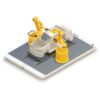Automotive Acoustic Materials Market Summary:
The automotive industry is constantly evolving, and one area that has seen significant advancements is automotive acoustic materials. These materials play a crucial role in enhancing the overall driving experience by reducing noise and vibrations inside the vehicle. The automotive acoustic materials market is expected to witness substantial growth in the coming years. This can be attributed to the increasing demand for quieter and more comfortable vehicles, as well as the growing awareness about the importance of noise reduction for driver and passenger comfort. One of the key factors driving the market is the stringent regulations and standards set by governments and regulatory bodies regarding noise pollution. Automakers are now focusing on incorporating advanced acoustic materials in their vehicles to comply with these regulations and provide a quieter cabin environment.
The rising trend of electric and hybrid vehicles is also contributing to the growth of the automotive acoustic materials market. These vehicles tend to produce less engine noise, making the cabin noise more noticeable. As a result, automakers are investing in innovative acoustic materials to ensure a peaceful and enjoyable driving experience for electric and hybrid vehicle owners. The market is segmented into damping materials, insulation materials, and absorbers. Damping materials, such as viscoelastic materials, are used to reduce vibrations and structure-borne noise. Insulation materials, on the other hand, are designed to block airborne noise from entering the cabin. Absorbers, including foam and fiber-based materials, are used to absorb and dissipate sound energy. The automotive acoustic materials market is witnessing significant growth due to the increasing demand for quieter and more comfortable vehicles. With the rise of electric and hybrid vehicles, automakers are investing in advanced acoustic materials to ensure a peaceful cabin environment. The market is expected to continue expanding as automakers strive to meet regulatory standards and enhance the overall driving experience for consumers.
Automotive Acoustic Materials Market Overview:
The Automotive Acoustic Materials Market overview provides a comprehensive understanding of the analyzed market. It includes an introduction to the market, its size, growth rate, and key trends. This aims to give clients a broad understanding of the market landscape. The market analysis of the Automotive Acoustic Materials Market delves deeper into the market dynamics, focusing on factors such as market drivers, challenges, and opportunities. It explores the macroeconomic and microeconomic factors affecting the market, industry regulations, and emerging market trends. The analysis provides valuable insights into the current and future market conditions.
The assessment of the Automotive Acoustic Materials Market is performed by taking various factors into consideration, like, for instance, the business expansion policies of key players, competitive analysis of the progress of new entrants and emerging players, and the revenue, financial, and opportunity analysis of market players. The also analyzed based on regional segmentation, type or technique, end-user spectrum, etc. This research implements the latest methodologies to help clients understand the overall market scenario and strategize accordingly. The Automotive Acoustic Materials Market report provides an overview of the different types of analysis conducted during the market research process, including but not limited to SWOT analysis, Porter's Five Forces analysis, PESTLE analysis, and market forecasting. These analyses provide a deeper understanding of the market dynamics and assist in making informed business decisions.
Major players included in the Automotive Acoustic Materials Market:
- Dowdupont
- BASF
- 3M
- Covestro
- Henkel
- Huntsman
- Lyondellbasell
- Toray Industries
- Sika
- Sumitomo Riko
- UFP Technologies
- Johns Manville
- CTA Acoustics
- Roush
- Tecman Speciality Materials
- Borealis
- Jh Ziegler
- Autoneum
- Nihon Tokushu Toryo
- Nichias Corporation
Automotive Acoustic Materials Market Segmentation:
By Material Type
- Polyurethane
- Polypropylene
- Textile
- Polyvinyl Chloride
- Fiberglass
- Acrylonitrile Butadiene Styrene (ABS)
- Others
By Component
- Bonnet Liner
- Cabin Rear Trim
- Door Trim
- Engine Top Cover
- Engine Encapsulation
- Fender Insulator
- Floor Insulator
- Headliner
- Inner Dash Insulator
- Outer Dash Insulator
- Parcel Tray Insulator
- Trunk Trim
- Wheel Arch Liner
By Application
- Underbody & Engine Bay Acoustics
- Interior Cabin Acoustics
- Exterior Acoustics
- Trunk Panel Acoustics
By ICE Vehicle Type
- Passenger Car
- Light Commercial Vehicle (LCV)
- Heavy Commercial Vehicle (HCV)
By Electric and Hybrid Vehicle Type
- Battery Electric Vehicle (BEV)
- Plug-In Hybrid Electric Vehicle (PHEV)
- Hybrid Electric Vehicle (HEV)
Future Market Analytics Focus Points:
- SWOT Analysis
- Key Market Trends
- Key Data -Points Affecting Market Growth
- Revenue and Forecast Analysis
- Growth Opportunities For New Entrants and Emerging Players
- Key Player and Market Growth Matrix
Automotive Acoustic Materials Market Competitive Analysis:
The competitive analysis of the Automotive Acoustic Materials Market assesses the competitive landscape of the market. It includes evaluating key players in the industry, their market share, business strategies, and competitive advantages. The competitive analysis also highlights the strengths and weaknesses of major competitors, allowing clients to understand the competitive positioning of companies operating in the market.
Objectives of the Study:
- To provide a comprehensive analysis on the Automotive Acoustic Materials Market by segmentation and by region
- To cater extensive insights on factors influencing the market growth (drivers, restraints, industry-specific restraints, business expansion opportunities)
- To anticipate and analyse the market size expansion in key regions- North America, Europe, Asia Pacific, Latin America and Middle East and Africa
- To record and evaluate competitive landscape mapping- strategic alliances and mergers, technological advancements and product launches, revenue and financial analysis of key market players
How our market research reports help clients:
Our market research reports provide valuable insights to clients in their decision-making process and support their growth and market capture efforts. They offer:
- Comprehensive understanding of market trends, dynamics, and growth potential.
- Identification of niche markets and emerging opportunities.
- Assessment of competitive landscape and strategic benchmarking.
- Insights into consumer preferences, buying behavior, and market demand.
- Risk assessment and mitigation strategies.
- Market forecasting and trend analysis for informed business planning.
- Understanding product development, pricing, and other strategies.
In case of any specific requirements or changes to the current table of content based on your scope, please contact us at: enquiry@futuremarketanalytics.com






















